LG 34UM67: UltraWide FreeSync Review
by Jarred Walton on March 31, 2015 3:00 PM ESTLG 34UM67 Display Uniformity
Given the size of the display, creating good uniformity can be difficult. Most of the display does reasonably well, with the corners tending to vary a bit more the center. The left side of our sample in particular looks a bit dim, but it’s only something you really notice when you look for it.
Starting with white uniformity, the center ends up being close to the brightest area, when most other sectors dropping off slightly. The center portion along with the bottom are all within 10%, which is a good result, but the top left and right corners fall off by up to 15%. Professionals would appreciate better uniformity overall, but for gaming the LG 34UM67 works well.
Black uniformity interestingly is a bit of a reverse from the white, with many areas showing slightly higher black levels than the center. However, our i1 Pro is not the best device for measuring black levels and the actual difference between 0.315 cd/m2 and 0.387 cd/m2 isn’t all the great when looking with your physical eyes, even though it’s a 23% difference. There’s a lot of variability in the charts, but mostly the corners seem to be the biggest outliers.
Compared to our earlier calibrated results, or uniformity contrast measurements have all fallen off quite a bit. Our measured contrast this time ranges from 465:1 on the bottom-right corner to as high as 662:1 just above the center, but I think most of the black levels were measured too high so the contrast results are only moderately useful.
Delta E shows similar uniformity again. The top-left edge and top-right seem to have the greatest variance, but for a non-professional display most of this discussion is academic.
The short summary is that uniformity on the LG 34UM67 is good but not exceptional. There will obviously be differences between panels, so where we had problems primarily on the corners and left/right edges, other displays may show more or less issues. Perhaps the most telling aspect is that prior to testing uniformity, I looked carefully over the display with a variety of solid background images to see if I could detect any problems. There are some very minor discolorations that show up primarily when viewing pure white, but the size of the display makes the corners more of an acute viewing angle so it often feels like that’s as big of a problem as display uniformity.


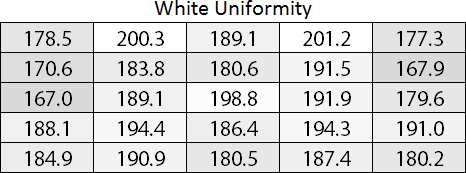
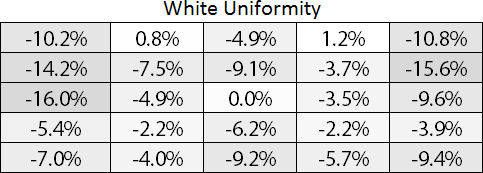
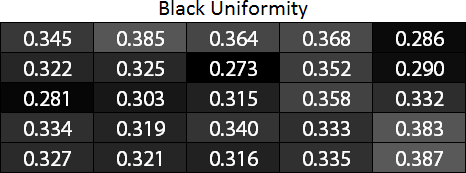
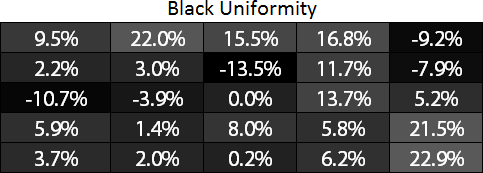
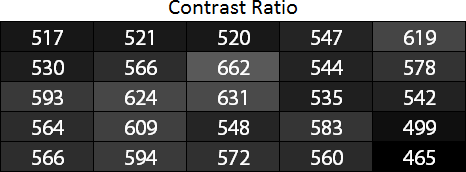
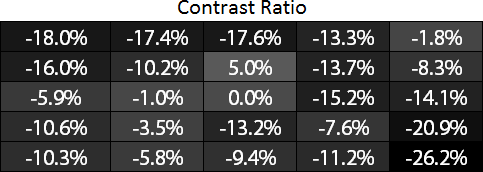
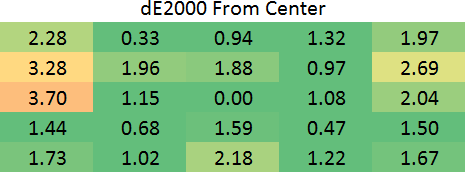








96 Comments
View All Comments
Crunchy005 - Wednesday, April 1, 2015 - link
more unsupported rather than proprietary nature. Proprietary seems to get thrown around to much.p1esk - Tuesday, March 31, 2015 - link
Double the resolution, then get the price down to $499, and I will consider it.wolrah - Tuesday, March 31, 2015 - link
"the screen went black and never came back"*snicker*
Asmodian - Tuesday, March 31, 2015 - link
Isn't FreeSync disabled when over the VRR? Your in game (F1) ghosting test is with FreeSync disabled. What is the ghosting like with FreeSync active? I understand overdrive is forced off whenever FreeSync is active.JarredWalton - Tuesday, March 31, 2015 - link
Behavior over the max VRR depends on the game setting -- it can be either VSYNC on (which will effectively cap FPS at max VRR) or VSYNC off. I personally leave it off, as I like being able to run at higher FPS.Dribble - Tuesday, March 31, 2015 - link
And his other point about ghosting - on other freesync monitors overdrive gets disabled when freesync is on, is that the case here?JarredWalton - Wednesday, April 1, 2015 - link
I took plenty of ghosting pictures to check this out as much as possible. From what I can see, overdrive ("Response Time" in the LG OSD) is fully active with or without FreeSync.Soulwager - Tuesday, March 31, 2015 - link
"AMD tells us that they drive a display at its max refresh rate when the frame rate drops below the cutoff"Could you test that? PCPer said the display was staying at it's MINIMUM refresh rate when your framerate drops below the cutoff.
JarredWalton - Tuesday, March 31, 2015 - link
Sadly I don't have any equipment suitable for testing the actual refresh rate, which is why I say "claims". Right now, I'm pretty sure that if you fall below 48 FPS the display refreshes at 48Hz. I suspect it's something AMD can change with driver updates. We're still waiting of CrossFire FreeSync as well, so maybe the next driver update will alter the way this works.dragonsqrrl - Tuesday, March 31, 2015 - link
This is not a good variable refresh rate display, plain and simple. In fact I would argue it's not a good desktop monitor in general. I think the fact that this monitor even came to market illustrates the difference between Nvidia and AMD's strategy and design philosophy.